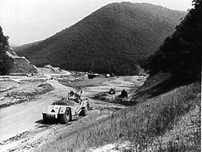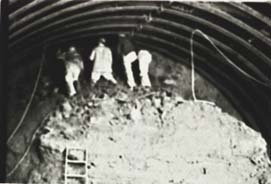

The construction of the East River Mountain Tunnel was of great importance, not only to the people of the two Virginias, but also to the people living on the entire eastern coast of the United States. Before the tunnel was built, everyone had to cross the mountain in order to get from Virginia to West Virginia. The mountain wasn't a very good way of traveling for several reasons. First, the road was very narrow and difficult to pass on. There were no guardrails and it was extremely foggy at night. Crossing the mountain during the summer took a considerable amount of time, not to mention what it was like in the winter. The snow-covered road was treacherous during the winter and sometimes even impassable. Therefore, the mountain was an inconvenience for many travelers.
Crossing the mountain also had good aspects. It offered a beautiful view of scenery throughout the year. There was a craft shop on top of the mountain and train rides were also available. These things made crossing the mountain more enjoyable.
Over all, a tunnel still seemed to be the best solution to this predicament. As a result, ground breaking ceremonies for East River Mountain Tunnel began on August 12, 1969. Governors Arch Moore and Mills Godwin pushed a plunger on a device which triggered a ground-breaking explosion with red, white, and blue smoke. This was only the beginning of a forty million dollar project, which was one of the largest of its kind ever undertaken by the West Virginia Department of Highways.
The construction of this tunnel provided many jobs. For example, Larry Payne worked as a chuck tender. That is someone who removes the first seven hundred feet of rock and mud. Once they reached the solid rock, they used dynamite. Dan Tibbs remembers performing this job: "We used TNT and then we took cellulite and soaked it with nitroglycerine. Then we drilled holes and filled the holes with it, and detonated it with plastic caps." These are just a few of the odd jobs that were performed.
The people had very muddy working conditions. Their jobs were difficult and time-consuming, but they were paid off in the long run. They received weekly wages ranging from three to four hundred dollars, which was based on a forty hour work week.
The workers faced many problems while building the tunnel. Caves underneath the mountain created sink holes. Part of the tunnel once sunk two feet. As a result, concrete had to be hauled in from Kingsport, Tennessee, to fill the holes. This procedure took about two months to complete. Another problem was remembered by Thurman Conley. "There were stakes on top of East River Mountain where the workers could zero in on the apparatus they had to dig the tunnel with. The deer kept tearing it down, so they sent off and got some lion manure. They spread it out there to keep the deer from tearing the stakes down."
Finally, all of the hard work was completed. On December 20, 1974, the ribbon cutting ceremony took place. Governor Moore landed two helicopters outside the tunnel while John Dalton, Lt. Governor at that time, also came.
Approximately 30,000 feet of lumber was used to support the tunnel. The whole project was a union job because West Virginia was responsible for a little over half of the tunnel. This was a result of the state line dividing West Virginia and Virginia being inside the tunnel. According to it, West Virginia owned 51% and the remaining 49% belonged to Virginia.
The East River Mountain Tunnel will always be thought of as one of the most important advancements ever achieved in the two Virginias. It has also been labeled as the "Doorway to Progress", "Key to the Future", and "Beginning of a New Era". Also, although the tunnel was a great accomplishment, the road across East River Mountain will never be forgotten.
copyright©bland county history archives all rights reserved 2000